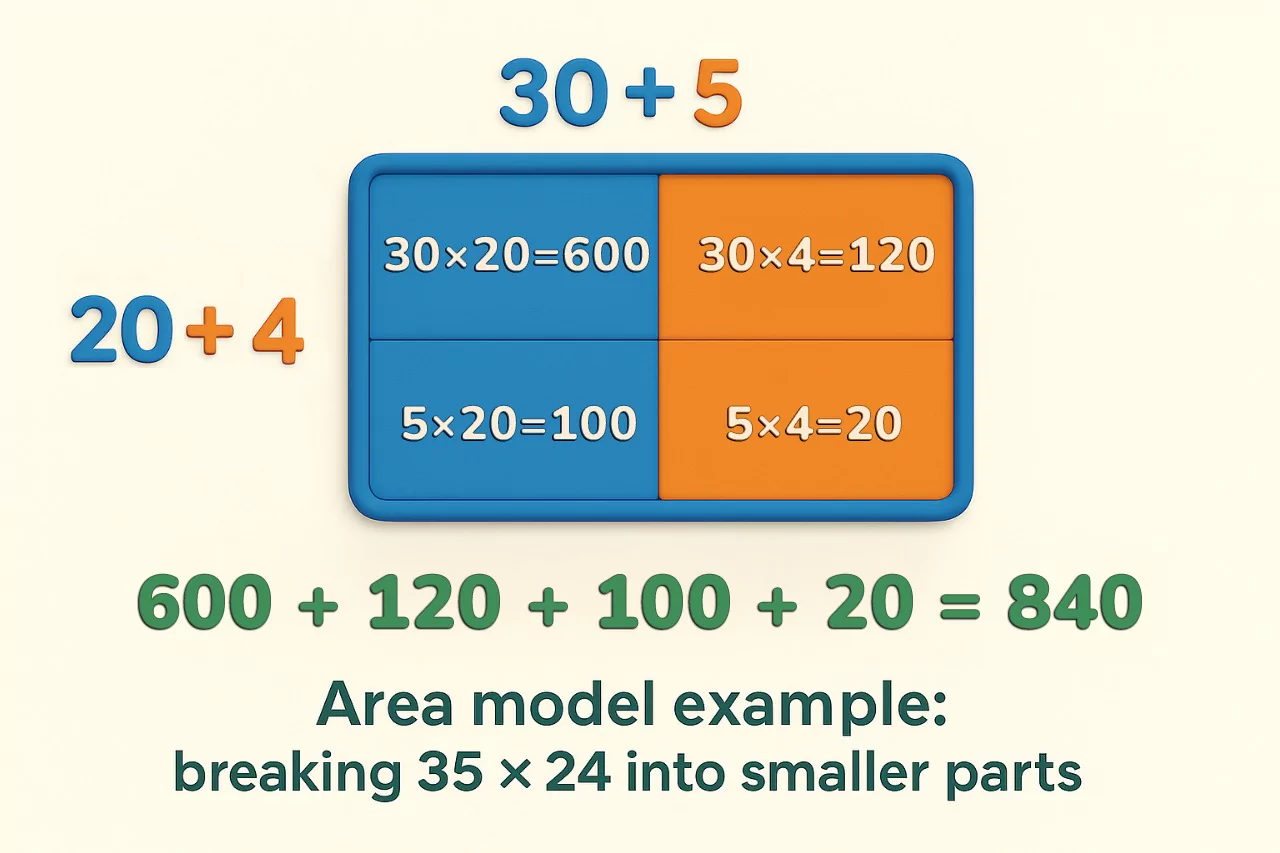What Are Area Models? A Simple Guide for Parents Helping With Math Homework

What Is an Area Model?
An area model is a rectangle or square diagram representing a math problem. The sides are labeled with numbers being used in the problem. For multiplication, each side usually shows a factor. Inside, the shape is divided into smaller boxes, and each box represents part of the calculation. Adding those parts together shows the full answer.This is a clear way to show how big problems can be broken down into smaller, more manageable steps.
Why Teachers Use Area Models
Teachers use area model multiplication tools because they make the “why” behind math clearer. Instead of only memorizing rules, kids see how multiplication (and division) work as they break numbers into parts and combine them again to form a whole.
For many learners, these diagrams build a deeper understanding of place value and number relationships. Area models also support different learning styles, as some children need to see a problem visually and break it down into more manageable amounts before the numbers “click.”
How To Use Area Models for Multiplication
Children can solve problems with area model multiplication once they know the basics.
Here’s how it works:
- Write each number in expanded form. For example, 35 becomes 30 + 5.
- Draw a rectangle and divide it into sections: a grid with rows and columns for each part of the numbers.
- Label the top with one number’s expanded form and the side with the other’s.
- Multiply the numbers where each row and column meet. Write the partial products in the boxes.
- Add up all the partial products. This total is the final answer.
Instead of treating multiplication as a set of rules to memorize, using area models helps kids understand why the steps work and gives them a solid foundation for more complex problems later on. (Looking for more ideas for teaching multiplication? Take a look at this guide.)

How To Use Area Models for Division
Division often feels more abstract for kids, but the same rectangle approach can help them see how a larger number can be broken into smaller parts.
The method often used is called “partial quotients”:
- Write the dividend (the number being divided) inside the rectangle.
- Place the divisor (the number you’re dividing by) along the left side.
- Ask: How many times can the divisor fit into the dividend in one large step? For example, in 555 ÷ 15, you might start with 15 × 20 = 300. Record 20 at the top and subtract 300 from 555.
- Repeat with smaller chunks (like 15 × 10 = 150, then 15 × 7 = 105) until what’s left is smaller than the divisor.
- Add the numbers (partial quotients) at the top (20 + 10 + 7 = 37). That’s the final answer (quotient).
Area Models in Fractions
Area models shine with fractions, too. By dividing a rectangle into equal sections, kids can see fractions as pieces of a whole, making them less mysterious. For example, shading three out of four parts shows three-fourths clearly.
These models also work for multiplying fractions. If you shade 2/3 of a rectangle blue and 3/4 red, the overlapping shaded area (violet) represents 6/12, which can be simplified to 1/2.
It’s an easy, creative way for kids to “see” fractions interacting, instead of only working with numbers on paper.
Common Mistakes Kids Make (and How To Help)
When kids first try area models with multiplication, they often run into the same snags. They might:
Mislabel the boxes. Encourage them to double-check that the numbers on the top and side line up correctly.
- Skip a multiplication. Remind them to fill every box, even if the product seems small.
- Forget the final addition. Walk through the last step together. Adding the partial products is what gives the final answer.
Slow down and check each stage to help your child catch these mistakes before they become habits.
Tips for Parents Helping at Home
Take the stress off working with area models for multiplication or division with your child with these practical strategies:
- Use graph paper. It helps kids keep numbers and boxes lined up neatly.
- Ask them to teach you. When children explain their thinking, they strengthen their understanding.
- Focus on effort. Celebrate their persistence when they take a long time to get the correct answer. This helps foster a growth mindset.
Build Stronger Math Foundations With Prodigy
Area models let children see math in action, turning numbers into something they can understand and work with. With your guidance, they’ll grow more confident as they break big problems into smaller steps and discover how numbers connect. Stay patient, celebrate progress, and nurture their curiosity. It all makes a difference!










